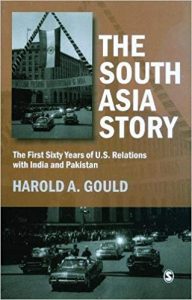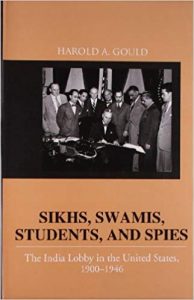The South Asia Story: The First Sixty Years of US Relations with India and Pakistan
by Harold A Gould
Sage Publications, New Delhi, 2010
136 pp.
Sikhs, Swamis, Students and Spies: The India Lobby in the United States, 1900-1946
by Harold A. Gould
Sage Publications, New Delhi, 2006
460 pp.
- The South Asia Story: The First Sixty Years of US Relations with India and Pakistan
by Harold A Gould
Sage Publications, New Delhi, 2010
136 pp.

THE BIRTH OF A GEOPOLITICAL PARTNERSHIP
The USA and India see their good diplomatic relations as a vital part of their foreign policy. That is, in fact, a quite recent awareness. In an admirable and fast-paced book Harold Gould follows the successive administrations of the US presidents, ‘from the militarized grand strategy promulgated by … the Cold War Hawks in the 1950s to the more nuanced diplomacy that now regards India as a key strategic partner’. This transition was completed only in 2005. The involvement of Gould with India dates from 1954, and he was an active lobbyist in Washington. His book is also one of a mission accomplished.
When India was still under the British, the USA saw in the independence movement on the subcontinent ‘a promising trend toward … democracy’. What followed Independence and Partition in 1947, was indeed a vibrant democracy in India. But in international matters India was non-aligned, and American foreign relations operated on the equation: a non-aligned country = a fellow traveller of Communism. Gould sees that as a major mistake. In South Asia, not communism, but ‘ethno-religious enmity’ between Hindus and Muslims was the main threat. In his eyes, Pakistan joined the Grand Alliance of the USA ‘solely … to equalize the imagined power gap vis-à-vis India’. In its turn, India got closer to the Soviet Union.
And China. Here the relationship froze with the 1962 frontier war. Gould calls it an expression of ‘Maoist self-righteousness’. Rather, the positions of both governments were left-overs from Imperial times (Neville Maxwell, India’s China War, 1970).
During the cold war India was a low priority on the US diplomatic agenda. Nixon (1969-1974) was more interested in rapprochement with China, and worried that India’s Bangla Desh war of 1971 could disrupt this process. India moved even closer to the Soviet Union.
During the administration of Gerald Ford (1974-1977), two events ensured that US-Indian relations did not improve. In 1974 India exploded a nuclear device, and Indira Gandhi suspended democracy during the Emergency (1975-1977). Behind-the-scenes pressure on Indira Gandhi by US well-wishers might well have contributed towards the end of the Emergency, knows Gould from inside sources.
Jimmy Carter (1977-1981) was the first to undertake, what Gould in the oiled language of diplomatic strategy calls, ‘an adaptive orientation to the proliferation challenge’. It took time. By 1991, partly as the result of its defeat in Afghanistan, the Soviet Union was out. Radical Islam now became ‘the pervasive doctrinal challenge to Western secularism’. For the first time, the strategic interests of the USA and India converged.
In a separate development, India awoke from its economic stupor. Narasimha Rao scaled down excessive state intervention in the Indian economy, in the so-called ‘end of the license raj’ of 1991. Gould greatly admires Rao whom he knew well.
Under George H. Bush (1989-1993), the India caucus on Capitol Hill tried to find ways to circumvent the non-proliferation strictures on India. A dialogue with India started ‘to end once and for all the atmosphere of pique… between the world’s two greatest democracies’. That process continued under Clinton (1993-2001). There were 14 formal and ‘numerous informal’ meetings between the Indian finance minister Jaswant Sing and Clinton’s representative Talbott.
George W. Bush (2001-2009) surprised Gould. ‘[N]o one could have imagined that his administration was destined to have a greater impact on U.S.-Indian relations than any since President Eisenhower’s first term’. The countries shared an aversion of Islamic fundamentalism. India staged a ‘spectacular entry into the global economy’. Perceptions were further smoothened by the now 120-member caucus, and ‘the emerging lobbying power of the two million strong Indian-American community, which some said had become as effective on the Hill as the so-called Jewish lobby’. Which is as much praise as a lobby in Washington can get.
The 18 July 2005 agreement on nuclear cooperation in Washington DC ‘finally put to rest the last vestiges of the Cold War in South Asia’.
Now there is what Gould calls ‘strategic compatibility’ between the USA and India. Indeed, relations point to much more. With somewhat overblown optimism, Fareed Zakaria even stresses the relations between the American and Indian societies (The Post-American World, 2009).
Harold Gould freely admits to his ‘democratic socialist’ leanings, but his book is not a political exercise. It shows that not so much the political leanings of the main players, but the strategic compulsions they feel, moves the story forward. Gould as a close observer has a vivid grasp of the subject. His book is, moreover, well researched. Gould’s succinct overview of the birth of this major geopolitical partnership fills a gap.
Published 12 November 2012
https://www.amazon.co.uk/gp/customer-reviews/R26HDUDNXH6440?ref=pf_ov_at_pdctrvw_srp
- Sikhs, Swamis, Students and Spies: The India Lobby in the United States, 1900-1946
by Harold A. Gould
Sage Publications, New Delhi, 2006
460 pp.

THE TROUBLESOME FIRST FORTY YEARS OF INDIAN MIGRATION INTO THE USA
In 1946 there were less than 10,000 Indians in the USA. Still they succeeded in overcoming a blanket ban on Indians immigrating and becoming US citizens. Harold Gould tells how they did it – and his story is surprisingly actual.
The first Indian immigrants into the USA came around 1904, and were mostly Sikhs, who settled in California. Foreigners could not hold property, so they made rental and leasing arrangements to practise agriculture. Or married with local spouses of Mexican descent. Some did well, and in their gurdwaras (temples) ethnic awareness rose. That was reinforced by discrimination. As Sikhs wear turbans, they were called ‘rag heads’. In addition, a different type of Indian immigrants came, young, urban, mostly Bengali, and attending American universities. About 1911 there appeared in Calcutta a series of articles, together a virtual immigration handbook, with instructions on how to prepare for the USA, what to take with you, what to say on arrival, which were the useful addresses, and even how to dress once you were in.
In November 1913 these immigrants organised themselves in Ghadr to overthrow the British Indian Government. On the East Coast they fell in with Empire bashing, and got support from left radical intellectuals. Gould gives an detailed sketch of the main people involved. Ghadr got monetary assistance from Germany, after 1917 the enemy of the USA. The Hindu-German Conspiracy Case of 1917-1918 put an end to most of its activities.
In 1918 the India Lobby (the capitals are Gould’s) started to work upon prominent mainstream Americans. Indian independence was the more easy sale. India was fashionable. Rabindranath Tagore got devotion on his several visits to the States. ‘The most beautiful man I ever saw in my life’, remembered a female admirer decades later. Gandhi, too, was revered, while Nehru provided secular credit.
But immigration and citizenship got big blows. The Immigration Acts of 1917 and 1924 excluded immigrants from the ‘Asiatic zone’ and introduced literacy provisions. Indian immigration virtually stopped. Worse, in the Thind Decision of 1923 Indians already US citizens were declared not `white’, hence not entitled to citizenship and property. The efforts to undo this decision form the central part of the book.
In 1939 Jagjith (‘J.J’) Singh, a westernised Indian, became president of the Indian League of America and involved prominent Americans. While a Chaman Lal made ‘no-holds-barred’ attacks on the British ally and stated that India was a ‘Vast Concentration Camp’ (his capitals), and while many Indians cherished a self image as members of an ancient civilization, J.J. Sing held soirées in his mansion in Washington to promote awareness of the Indians’ problems with a good glass.
In 1941 America entered the war. Churchill was adamant in suppressing the demand for Indian independence, and Roosevelt felt that this damaged the ideological underpinning of the war effort. That tension was largely hidden from public view till July 1944, when Drew Pearson of the Washington Post published William Phillips’ letter to Roosevelt. Phillips, the personal representative of Roosevelt in India, wrote that Britain should announce that India would become independent on conclusion of the war. Gould gives a fascinating account with hitherto unknown details of how this letter ended up on Pearson’s desk. ‘Deep throat’ Robert I. Crane, a junior officer in the State Department, who realised the importance of the letter, handed it to Indian friends to copy. The Roosevelt administration did not distance itself from this letter.
J.J. had ‘mastered the art of lobbying’. His efforts bore fruit in 1944 when Representative Celler introduced his amendment to include a quota of 100 Indians in the naturalisation statute. The reasons the proponents gave sound fresh. They also (Gould does not point that out) were somewhat forced. Indians had been ‘allies’ in the war (but as soldiers of the British Empire); they were ‘quite modern’ (that was a very small proportion); they spoke English (well, most did not) and India’s market was a ‘huge untapped reservoir’ (that ‘untapped’ is true even today).
In fact geopolitical reasons carried more weight. `We cannot have goodwill with a country while denying entry to its citizens’. Goodwill was needed. India had to chose between `democracy as we know it’ or communism. The revised Celler bill was passed on June 27, 1946.
From the material that Professor Gould presents in his book, one can draw lessons for people who face comparable difficulties today. Immigration rules depended on perceived compatibility of immigrants with the host country; self organisation worked best when a connection was made with the main population, businessmen had more impact than political radicals. The sound of money and geopolitics changed the music for the politicians. And, of course, the untiring efforts of the Indian immigrants for over four decades, which Gould has uncovered for us. Read it.
Published 20 March, 2013
https://www.amazon.co.uk/gp/customer-reviews/R3HBX9XTVD72VE?ref=pf_ov_at_pdctrvw_srp
